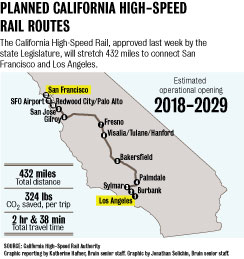The possibility of being able to travel from UCLA up to the Bay Area by train in a little less than three hours is speeding toward California.
Last week, California lawmakers voted to begin building the first leg of the country’s first high-speed rail line, which will eventually link Los Angeles to San Francisco. Had the bill been defeated, the project would not have been able to continue.
In addition to the possible transportation ease it could give to UCLA students, some legislators have said the rail will bring more jobs into California, stimulating economic development.
“In 2008, California voters decided to create jobs and modernize our state’s rail transportation system,” Gov. Jerry Brown said in a statement on his website after the vote to increase funding for the project. “The Legislature took bold action (last week) that gets Californians back to work and puts California out in front once again.”
Though experts disagree on the rail’s long-term effects on the state economy, students and the Los Angeles area could see benefits from this development.
The simple nature of train travel in comparison to air travel could be a bonus for students, said Daniel Mitchell, a professor emeritus at the UCLA Luskin School of Public Affairs and the UCLA Anderson School of Management.
Melody Ma, a second-year biology student from the Bay Area, said if the train were a cheaper alternative to flying and if the stations in both Los Angeles and San Francisco were conveniently located, she would be interested in taking the high-speed rail when she travels home for holidays.
“It would really depend on exactly how much more expensive (train tickets were) to me,” she said. “I would use it, if I still live in the L.A. area after I graduate”.
The state Senate approved the initiative by a 21-to-16 vote, and the state Assembly voted 51-to-27 in favor last week.
The narrow votes reflected the legislators’ split opinions about the rail, Mitchell said.
Legislators say the rail will create an economic boom, but detractors think the project is too costly.
Voters passed a ballot measure to fund the California High-Speed Rail project in 2008, putting almost $10 billion into the project, and more recently, the federal government said it would partially fund the project with $3.3 billion.
Last week’s vote by the Legislature gave the green light to move forward with the rail’s initial construction, putting an additional $24.6 million toward future program management and administration.
The high-speed rail legislation also allocates about $2 billion to upgrade current systems of Caltrain and commuter rail lines in Los Angeles.
Estimates for the ultimate cost of the rail have varied between $33 billion and $99 billion, and are currently at $68.4 billion, according to the 2012 California High-Speed Rail business plan.
Service along the line is scheduled to begin in 2018, according to the California High-Speed Rail Authority’s 2012 business plan, and passengers should be able to travel from San Francisco to Los Angeles by 2029. The closest rail stop to UCLA would be at Union Station.
An economic forecast released last month by the UCLA Anderson School of Management concluded that the rail will not necessarily stimulate economic prosperity in California.
The Anderson forecast looked at the economic impact associated with the California rail by analyzing the much-used Japanese Shinkansen high-speed rail line, which runs the length of Japan.
Analysts did not find patterns of increased economic development in any of the states the Japanese line ran through, according to the report.
When making job predictions, California High-Speed Rail contractors looked at the growth stimulated by interstate highways and transcontinental railroads as well as high-speed rails and estimated that the rail would create 990,000 jobs that lasted at least a year over a period of 15 years. In contrast, the forecast looked only at the growth around high speed rails, said Jerry Nickelsburg, a senior economist with the UCLA Anderson Forecast.
While the possibility of less than anticipated economic growth could give some California residents pause, the Anderson Forecast is not necessarily a blueprint for the California rail’s future, Nickelsburg said.
“(Japan’s rail) does reflect on what might happen in California, but any differences would be because California is not Japan,” he said.
Though experts are at odds about the economic impact of the planned rail system, the project includes funding for some Los Angeles County infrastructure projects.
Dave Sotero, a spokesman for the Los Angeles County Metropolitan Transportation Authority, said Metro and Los Angeles County benefit from the passage of the high-speed rail funding bill.
For example, part of the high-speed rail bill will help fund the Regional Connector project, an underground light-rail project that would make it simpler to cross through Los Angeles County, Sotero said. Simpler public transportation could help students explore Los Angeles.
The rail legislation awaits a signature from Gov. Brown before the funding can materialize.
